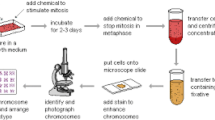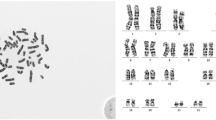Abstract
Automated Giemsa-banded chromosome image research has been largely restricted to classification schemes associated with isolated chromosomes within metaphase spreads. Overlapping chromosomes cause difficulties in the automated chromosome karyotyping process. First, overlapping chromosomes must be recognised and decomposed into the proper chromosome parts. Secondly, the decomposed chromosomes must be classified. The first difficulty is associated with image segmentation. The second area is a pattern recognition problem. Even if chromosomes within overlapping clusters are decomposed properly, classification capability is impaired due to feature distortion in the overlapped regions. In normal human metaphase spreads, chromosomes occur in homologous pairs for the autosomal classes, 1–22, and X chromosome for females. This research presents a homologue matching approach for overlapped chromosome recognition. The undistorted grey level information in isolated chromosomes is used for identifying overlapped chromosomes. An isolated chromosome prototype is obtained using neural networks. Dynamic programming and neural networks are compared for matching the prototype to its overlapped homoloque. The homologue matching method is applied to identifying chromosome 2 in 50 metaphase spreads. Experimental results showed that homologue matching using dynamic programming matching based on the density profile achieved a higher correct recognition rate than homologue matching using three different neural network approaches.
Similar content being viewed by others
References
Tso M, Graham J. The transportation algorithm as an aid to chromosome classification. Pattern Recognition Letters 1983; 1: 489–496
Tso M, Kleinschmidt P, Mitterreiter I, Graham J. An efficient transportation algorithm for automatic chromosome karytyping. Pattern Recognition Letters 1991; 12:117–126
Stanley RJ, Keller J, Gader P, Caldwell CW. Data-driven homologue matching for chromosome identification. IEEE Transactions on Medical Imaging (in press)
Stanley RJ, Keller J, Gader P, Caldwel CW. Homologue matching using the Choquet integral. Proceedings of the 36th Rocky Mountain Bioenineering Symposium 1998; 34:315–320.
Keller J, Gader P, Caldwell B. The principle of least commitment in the analysis of chromosome images. Proceedings of the SPIE Symposium, Oe/Aerospace sensing duel use photonics 1995: 178–186
Medicine and the computer: classifying chromosomes. British Medical Journal 1968; 2 (615): 426
Ji L. Fully automatic chromosome segmentation. Cytometry 1994; 17:196–208
Chen Y, Dougherty ER. Optimal and adaptive recostructive granulometric bandpass filters. Signal Processing 1997; 61:65–81
Popescu M, Gader P, Keller J, Klein C, Stanley J, Caldwell C. Automatic karyotyping of metaphase cells with overlapping chromosomes. Pattern Recognition 1998 (accepted)
Gintingsuka A. Using pale paths and cross section sequence graphs to segment chromosomes automatically. MSEE thesis, Electrical and Computer Engineering, University of Missouri-Columbia, 1996
Gonzalez RC, Woods RE. Digital Image Processing. Addison-Wesley, New York, 1992
Zimmerman SO, Johnston DA, Arrighi FE, Rupp ME. Automated homologue matching of human G-banded chromosomes. Computers in Biology and Medicine 1986; 16:223–233
Piper J, Granum E. On fully automatic feature measurement for banded chromosome classification. Cytometry 1989; 10:242–255
Author information
Authors and Affiliations
Additional information
Grant Support: This research was supported in part by a grant from the University of Missouri Research board and training grant 5 T15 LM/CA07089-04 from the National Library of Medicine and National Cancer Institute, Bethesda, MD.
Rights and permissions
About this article
Cite this article
Stanley, R.J., Keller, J., Gader, P. et al. Homologue matching applications: Recognition of overlapped chromosomes. Pattern Analysis & Applic 1, 206–217 (1998). https://doi.org/10.1007/BF01234768
Received:
Revised:
Accepted:
Issue Date:
DOI: https://doi.org/10.1007/BF01234768




